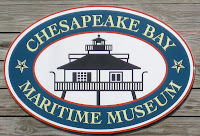On the way, we saw quite a bit of storm damage. This tree had fallen against the garage.
And a guy was busy at work cleaning up this mess. The phone lines are above ground here, so trees easily knock them down. This one had.
Near the marina we saw this truck.
Okay…….!
As we’ve walked around town the past two days we have seen several of this style house. It is called and an “X House” according to the locals. We wondered what the layout inside would be?
This is a Skip Jack under sail. They are still allowed to dredge oysters, but only under sail power. Back in 1885 it was outlawed, so they have the motor to power the vessel in the dinghy behind the Skip Jack. If they are dredging, it needs to be pulled out of the water on davits at the back so the boat is visibly only under sail power.

After our walk in to the harbor, we head out to St. Michael, Maryland. Tilghman is on the Choptank and we need to navigate Knapps Narrows to get to Chesapeake Bay on the opposite side of the island. A couple of skinny spots, but nothing white knuckle. Thankfully!
We passed the Tilghman Island Inn where we had dinner last night.
Shortly after arriving at the marina in St. Michaels, we were greeted by Big Jim and his wife Ann. They happened to be sitting in the restaurant overlooking the marina and Jim recognized our boat. So we had a fun visit with them.

It was another hot, humid day, but we hiked in to St. Michaels and headed for the Maritime Musuem.
Along the way we passed a cemetery. You don’t think this could possibly be the guy who invented……nah.

The Chesapeake Bay version of a playhouse.

It was a large museum with many separate buildings and exhibits. Everything from boat building, to oystering, crabbing, duck hunting, a lighthouse, a dock where you could crab, to a gallery. The gallery had a display of photographs by a fellow photographer friend of Big Jim’s. The display was all about the Watermen of the Chesapeake. We recognized a familiar face in one of the photos. It was the man from the museum in Crisfield who gave us a tour of the town and the crab processing house.

Most of the lighthouses in area where screw pile lighthouses. They legs that supported the platform of the lighthouse were screwed in at an angle for greater strength. Back in the 1800’s this was accomplished by anchoring a platform and then either men or a horse would slowly turn it and screw it deep into the bottom. Even when the Bay ices over, the tide still rises and falls which puts tremendous pressure on these supports. All but a few screw pile lighthouses where destroyed or damaged because of it.
When I first saw this, I thought it was an ice house. It does look like one and is even on skids. It’s a fishing shanty or ark. Watermen would tow it behind their boats and drag them up on shore for living quarters when they went to fish certain areas. Little villages of them would appear on shorelines during certain times during fishing seasons.


If you click on this map, it will enlarge it and you can see just where we are. This is an amazing body of water.
I tried to explain the other day what a trot line is for crabbing. Even better, here’s a picture. Every few feet some type of bait, (chicken necks, bull lips, or firm meat) is attached. The trot line can be a mile long and the waterman boats along lifting the line and scooping off any crabs with a net. Not a colander!
The museum had a very interesting exhibit on duck hunting. This boat is referred to as an Ice Box Boat. When the water froze the hunter would push it out to a weak spot on the ice and push it through. He would then lay inside it and wait for ducks. The part he lay down in was called a coffin. I can see why. Jeez, it had to be cold!
Back at the museum in Crisfield I had taken a photo of a punt gun. Here’s one mounted on the boat. They were outlawed for good reason.

Undaunted, people made their own versions. Even more devastating. They were home made and dangerous. (you think??!!) 3 to 12 muzzle loading barrels were mounted together and a gunpowder trench across the top was used to fire it. It had a 10 foot wide spread at 30 yards. Good bye ducks!


















No comments:
Post a Comment